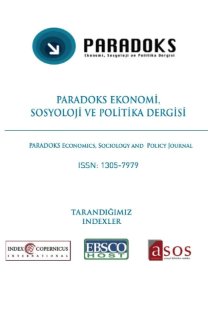Gelişmekte Olan Ülkelerde Doğrudan Yabancı Yatırımlar ve Cari İşlemler Arasındaki Nedensel İlişkiler (1990–2011)
Doğrudan Yabancı Yatırım (DYY)’ların cari işlemler bilançosu (CİB) üzerinde dolaylı ve dolaysız olmak üzere etkileri söz konusudur. Bu etkilerin bir kısmı olumlu iken, bir kısmı ise cari işlemler bilançosunda açıklara neden olmaktadır. Dolayısıyla DYY’ların cari işlemler üzerine net etkisi belirsizdir. DYY’larının cari işlemler bilançosu üzerindeki etkilerini ele alan çalışmalar, özellikle küreselleşmenin hız kazandığı 1990 sonrası döneme rastlamaktadır. Bu çalışmada Gelişmekte Olan Ülke (GOÜ)’lerde DYY ile cari işlemler bilançosundaki gelişmeler arasındaki nedensel ilişkiler inceleme konusu yapılmıştır. 1990-2011 dönemi için 30 orta üst gelirli GOÜ’yi dikkate alarak yapılan testlerde DYY’lar ile cari işlemler bilançosu arasında iki yönlü nedensellik ilişkisi yakalanmıştır. Bu sonuçlara göre GOÜ’lerde DYY girişleri, bu ülkelerin cari işlemler bilançosunda açıklara neden olmaktadır. Böyle bir sonuç, GOÜ’lerdeki DYY’ların ülkenin ithalatını doğrudan ve dolaylı bir şekilde uyararak ve kar transferleri ile cari işlemler açıklarını artırdığı anlamına gelmektedir.
Anahtar Kelimeler:
Doğrudan Yabancı Yatırımlar, Cari İşlemler, Gelişmekte Olan Ülkeler, Nedensellik
Causal Relationship Between Foreign Direct Investment and Current Account in the Developing Countries
Foreign Direct Investment (FDI) has direct and indirect effects on the current account balance (CAB). While some of these effects are positive, some of it is caused by the current account deficits in the balance. Thus, the net effect on the current account of foreign direct investments is uncertain. Studies examining the effects on the current account balance of foreign direct investments coincide especially the post-1990 period with the speed of globalization. This study examines causal relationships between FDI and current account in the developing countries. In the tests taking into 30 Developing Countries with mid-upper income for the period 1990-2011 caught a two-way causal relationship. These results indicate that FDI inflows in the developing countries lead to deficits these countries' current account. Such a result means increase the transfer of profits and the current account deficits stimulating the country's imports directly and indirectly.
___
- Aizenman, J. And I. Noy (2006) “FDI and Trade-Two-way Linkages?”, The Quarterly Review of Economics and Finance, 46: 317-337.
- Arellano, Manuel, and Stephen Bond (1991), “Some Tests of Specification for Panel Data: Monte Carlo Evidence and an Application to Employment Equations” The Review of Economic Studies, 58 (2), pp. 277-297.
- Calvo, G., Leiderman, L., Reinhart, C.,(1996). “Inflows of Capital to Developing Countries in the 1990s”. Journal of Economic Perspectives, 10,123-139, Spring.
- Ehimare, Omankhanlen Alex (2011), “Foreign Direct Investment and Its Effect on The Nigerian Economy”, Business Intelligence Journal, July, 253-261.
- Falk, M., Hake, M. (2008) “A Panel Data Analysis on FDI and Exports”, FIW Studien, FIW Research Reports No: 012.
- Fry, M., Claessens, S., Burridge, P., Blanchet, M., (1995). “Foreign Direct Investment, Other Capital Flows and Current Account Deficits: What Causes What?”. Policy Research Working Paper No. 1527, World Bank.
- Genç, Murat Can, M. Kemal Değer ve Metin Berber; (2011), “Human Capital and Export: Panel Data Causality Analysis on Provinces in Turkey”, İktisat, İşletme ve Finans Dergisi, 26(299), ss. 91-105.
- Holtz-Eakin, Douglas, Whitney Newey and Harvey S. Rosen; (1988). “Estimating Vector Autoregressions with Panel Data” Econometrica, 56 (6), pp.1371– 1395.
- Jansen, K. (1995) “The Macroeconomic Effects of Direct Foreign Investment: The Case of Thailand” World Development 23, 193-210.
- Kaur, M., S. S. Yadav, and V. Gautam (2012) “Foreign Direct Investment and Current Account Deficit- A Causality Analysis in Context of India” Journal of International Business and Economy, 13 (2): 85-106.
- Liuyong, Y. and Z. Yanping, (2007) “Empirical Analysis of the Impact of FDI on China’s Balance of Payments”,
- http://ieeexplore.ieee.org/stamp/stamp.jsp?tp=&arnumber=4340757 (Erişim Tarihi: 01/03/2013).
- Mencinger, Joze (2009), “The “Addictıon” with FDI and Current Account Balance”, Ekonomskı Horızontı, 11 (2): 5-17.
- Onwuka, K. O and K. Y. Zoral (2009), “Foreign Direct Investment and Imports Growth in Turkey”, Journal of Yasar University, 4(15): 2357-2380.
- Prasanna, N. (2010) “ Impact of Foreign Direct Investment on Export Performance in India”, Journal of Social Science, 24(1): 65-71.
- Samsu, S. H., A. M. Derus and A. Ooi (2008), “Causal Links Between Foreign Direct Investment and Export: Evidence from Malaysia”, International Journal of Business and Management 3(12): 177-183.
- Seabra, Fernando and Lisandra Flach, (2005) “Foreign Direct Investment and Profit Outflows: A Causality Analysis for the Brazilian Economy” Economics Bulletin, 6 (1): 1-15.
- Siddiqui, Danish Ahmed and Ahmad, Mohsin Hasnain (2012), “The Causal Relationship between Foreign Direct Investment and Current Account: An Empirical Investigation for Pakistan Economy” European Journal of Economics, Finance and Administrative Sciences, Issue, 44: 107-116.
- United Nations Conference on Trade and Development (UNCTAD) (2002) World Investment Report 2002: Transnational Corporations and Export Competitiveness, Geneva.
- World Bank, 2012, World Development Indicators.
- Yalta, Yasemin, (2011), “Uncovering the Channels Through Which FDI Affects Current Account: The Case of Turkey”, Department of Economics, TOBB University of Economics and Technology, Working Paper No: 11-08.
- Yaylı, Ş. Ve M. K. Değer (2012), “Doğrudan Yabancı Yatırımlar ve İstihdam Arası Nedensel İlişkiler: Gelişmekte Olan Ülkeler Üzerine Dinamik Panel Nedensellik Analizleri (1991-2008)”, Finans Politik ve Ekonomik Yorumlar, 49 (568): 43-52.
- Zhang, K.H. (2006) “How Does FDI Affect a Host Country’s Export Performance? The Case of China”,
- http://faculty.washington.edu/
- karyiu/confer/xian05/papers/zhang.pdf (Erişim Tarihi: 01/02/2013).
- ISSN: 1305-7979
- Yayın Aralığı: Yılda 2 Sayı
- Başlangıç: 2005
- Yayıncı: Sema AY
